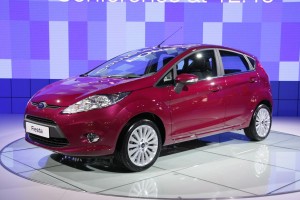Nearly a century ago, automotive pioneer Henry Ford was fond of telling customers they could order a car “in any color, as long as it’s black.” Right now, his great-grandson William Clay Ford, Jr. has to tell buyers they can order a new Ford in almost any color as long as it is not Tuxedo Black…or several shades of red.
The Japanese disaster trifecta that was touched off by a massive earthquake – then followed by a tsunami and a partial nuclear meltdown – damaged scores of parts plants and put production by most major Japanese automakers temporarily on hold. (Click Here for more.) Not only are conventional car parts, like engines, plastic panels and electronic chips gone into short supply but now it appears the world’s automakers could be facing a serious pigment panic.
Nearly three weeks after the earth first shook, a key plant in northeast Japan run by chemical company Merck is still down and a spokeswoman for the German company says it could be as much as two months more before the facility is back in operation.
“For both the timing of the repair start and for its timely completion, we are dependent upon the availability of infrastructure and utilities, as well as upon developments at the Fukushima power plant,” Merck’s Phyllis Carter told the Associated Press.
In many instances, automakers in Japan and other parts of the world have been lining up alternative sources for interior panels, tires and electronic engine controllers. But it seems the Merck plant is the world’s only source for a number of popular paint pigments used in such hues as Tuxedo black and, in Ford’s case, three different shades of red that are used on models such as the Ford Fiesta and Lincoln Navigator.
The maker has had to advise dealers that it can no longer take orders for vehicles in those shades, hoping that buyers will opt for alternative colors.
Now, Chrysler is telling the same thing to dealers. And it is likely that a number of other makers could be forced to take similar actions depending on how much paint they have in stock and how long it ultimately takes Merck to get its plant back in business.
The problem is that global automakers generally do not keep large inventories of anything, these days, relying on so-called Just-in-Time production systems to reduce their warehousing costs and help improve quality. The downside is that when a supplier runs into trouble a carmaker can be left high-and-dry.
That happened to Ford several years ago when production was disrupted at a seating supplier and Ford had to produce some of its SUVs without seats, warehousing them until shipments resumed. Since auto bodies are normally painted before final assembly, that approach would be unworkable.
Would buyers, unable to find the right car – or color – consider switching to another brand?
“Yes, they would,” suggested Art Spinella, “though that’s very brand specific,” adds the chief analyst for West Coast-based research firm CNW Marketing.
Ford is lucky, if CNW research proves accurate, since it has some of the most loyal buyers on the market. Only 6% would go elsewhere after a 90-day delay, and that drops to less than 3% for those seeking to buy a Ford truck. However, other brands, like Subaru, could lose as much as a third of their buyers if the right product weren’t available for an extended period, according to Spinella. (For more on the CNW study, Click Here.)

